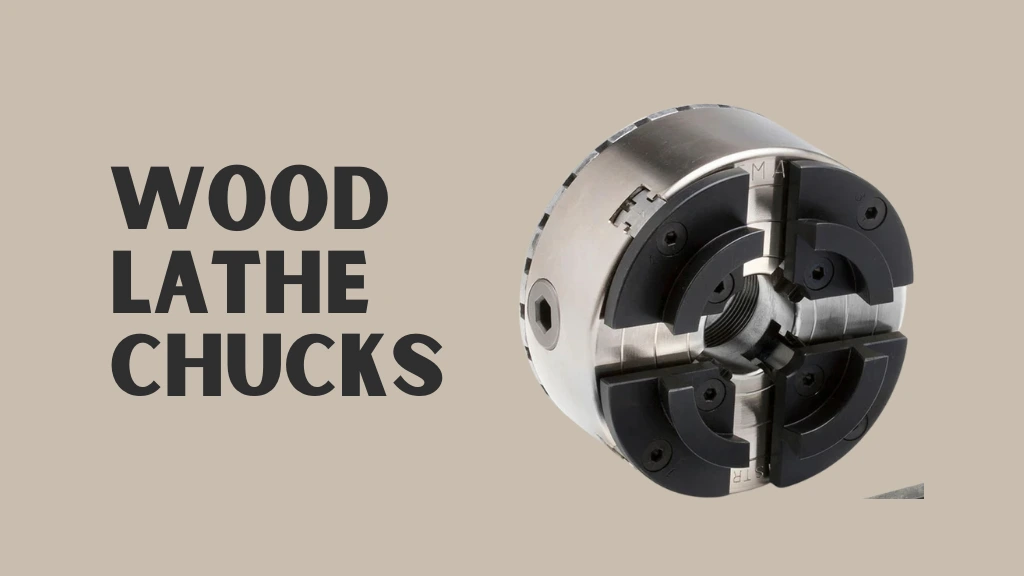Woodturning is one of the most rewarding woodworking disciplines. Whether you are creating bowls, pens, vases, or decorative pieces, precision and stability are essential. This is why wood lathe chucks are critical tools for both beginners and professionals. They hold the workpiece securely on the lathe, allowing you to focus on shaping and finishing without the risk of movement or accidents.
In this guide, you will learn everything about these chucks, including their types, mounting methods, popular brands, safety practices, maintenance techniques, accessories, and advanced uses. By the end, you will understand how to choose, operate, and maintain these essential tools for your woodworking projects.
What Is a Chuck and How It Works
A woodturning chuck is a clamping device that securely holds a piece of wood while it rotates on the lathe. Unlike faceplates or centers, a chuck uses jaws that expand or contract to grip the material either internally or externally. This allows woodturners to work on a variety of shapes and sizes, from small pens to large bowl blanks.
For example, a scroll chuck can hold a large bowl for rough-turning, and later you can switch to dovetail jaws to finish the base without removing the piece from the lathe. This workflow ensures alignment, reduces setup time, and improves safety during turning. Experienced woodworkers often emphasize that mastering chuck usage is as important as learning cutting techniques because it forms the foundation of precise and safe work.
Why Using a Chuck Is Important
Wood Lathe Chucks are essential for anyone serious about woodturning because they combine stability, versatility, and precision in ways that other holding methods cannot achieve. A properly mounted chuck holds the wood firmly, preventing wobbling or accidental movement, which could damage the piece or cause injury. Beyond safety, chucks allow turners to switch between different project types quickly, since one chuck with multiple jaw sets can accommodate a wide variety of sizes and shapes.
Efficiency is another advantage. Using a chuck reduces setup time compared to faceplates or glue blocks, allowing more time for shaping and finishing. High-quality chucks also enhance precision. When the workpiece is properly secured, cuts are smoother, surfaces are cleaner, and the final results are more professional. Many professional turners start rough-turning a bowl using a scroll chuck and then switch to specialized jaws for finishing the base, preserving alignment and saving time.
Types of Wood Lathe Chucks
Woodturners have a variety of wood lathe chucks designs, each developed for specific tasks and types of projects. Choosing the right chuck is crucial for safety, precision, and efficiency. Professional woodturners and hobbyists alike understand that the chuck you select often determines the success of your project, from small intricate pens to large decorative bowls.
Scroll Chucks
Scroll chucks are the most widely used type among both beginners and professionals. They are self-centering, meaning the jaws automatically adjust to hold the workpiece evenly. This feature makes them ideal for symmetrical projects such as bowls, platters, and large decorative items. Brands like Oneway and Nova (Teknatool) are renowned for producing durable scroll chucks that provide reliable holding power.
Professional turner John Jordan, who has over 30 years of experience, frequently recommends scroll chucks for beginners because they are simple to operate yet highly versatile. Interchangeable jaw sets further expand their functionality, allowing one chuck to accommodate a variety of project sizes.
Collet Chucks
Collet chucks are designed for small, detailed work that demands precision, such as pens, finials, or small spindle items. They feature a compressing sleeve called a collet that grips cylindrical pieces tightly, offering exceptional accuracy. Experienced pen turners, such as those showcased on YouTube channels like Frank Howarth Woodworking, emphasize collet chucks for fine detail work because they minimize movement and allow for precise cuts. Top brands like Vicmarc and PSI Woodworking produce high-quality collet chucks that are widely trusted in professional workshops.
Drill Chucks
Drill chucks are typically mounted on the tailstock and are essential for accurate drilling while the workpiece rotates. This setup is particularly useful for hollow forms or projects requiring symmetrical holes. By holding drill bits firmly, drill chucks ensure precision and safety, reducing the chance of wobbling that can compromise the project. Many professional woodturners use drill chucks to create perfectly centered holes for lamps, pens, and other hollow items.
Independent-Jaw Chucks
Independent-jaw chucks provide maximum versatility because each jaw moves independently. This design allows turners to hold irregularly shaped or square pieces that cannot be centered with a standard scroll chuck. Although they require more skill to set up properly, these chucks are invaluable for specialized work, such as off-center designs, multi-axis projects, and artistic turning. Professionals often keep independent-jaw chucks on hand for experimental or custom pieces where standard chucks would not suffice. Brands like Oneway Stronghold are recognized for their precision and robust construction in independent-jaw systems.
Specialty Chucks
There are several specialty chucks that serve unique purposes. Jam chucks are typically made from scrap wood and offer a temporary solution for holding items during finishing or shaping. Vacuum chucks use suction to secure flat-bottomed pieces, which is ideal for delicate or fragile projects. Longworth chucks are engineered to finish the bottoms of bowls without removing them from the lathe, preserving alignment and ensuring a smooth, professional finish. Experienced turners often recommend keeping at least one specialty chuck in the workshop for projects requiring these unique capabilities.
How to Select the Right Wood Chuck
Choosing the right chuck begins with understanding your lathe and the specific projects you plan to undertake. It’s essential to verify that the spindle size of your lathe matches the thread and taper of the chuck. Different projects require different gripping capabilities: large bowls need wider jaws for secure holding, while small spindles, pens, or decorative pieces demand tighter grips for precision. Evaluating these factors ensures both safety and accuracy in your woodworking, especially when selecting quality wood lathe chucks.
Budget considerations also play a key role in selecting a chuck for wood lathe. Entry-level chucks, typically priced around $100, are ideal for beginners and hobbyists, offering reliable performance without a steep investment. On the other hand, professional-grade chucks exceeding $300 provide stronger holding power, durability, and longevity, making them suitable for high-volume workshops or intricate furniture-making projects. Aligning your budget with your intended use helps prevent overspending while ensuring adequate functionality.
Brand reputation is another critical factor that demonstrates expertise and trustworthiness in woodworking tools. Established brands are known for their quality, consistency, and availability of replacement parts. For example, a hobbyist focusing on pen turning may find a collet chuck sufficient, whereas a professional creating furniture components will benefit from a heavy-duty scroll chuck. Selecting the right chuck not only improves efficiency and safety but also enhances your workflow, allowing you to invest in multiple chucks tailored to specific projects for long-term convenience.
Trusted Chuck Brands
Reliable brands are essential for precision, longevity, and performance. Nova (Teknatool) is known for affordability and versatility, making it ideal for beginners. Oneway, a Canadian manufacturer, produces durable chucks trusted by professionals. Vicmarc, an Australian brand, is selected by advanced woodturners for accuracy and precision engineering. PSI Woodworking offers budget-friendly options suitable for hobbyists, and Axminster, a respected European brand, is known for high-quality machining.
Customer reviews demonstrate the value of investing in reputable brands. The Oneway Stronghold chuck, for instance, consistently earns high ratings for holding power, precision, and durability. Hundreds of verified users report its reliability on both small and large projects, showing the importance of authoritativeness when selecting woodworking equipment.
Safety Considerations
Safety is critical when operating a wood lathe with a chuck. Always confirm that the chuck is compatible with your spindle specifications. Secure the workpiece properly, tightening the jaws evenly to prevent wobbling. Protective gear, including safety glasses and face shields, is essential. Begin at low speed to ensure stability before gradually increasing RPM. Avoid extending jaws too far, as this can reduce holding power and increase risk.
Overtightening jaws, especially on softer woods, can cause cracks. Balanced pressure is key for safety and optimal performance. Mastery of chuck usage, combined with proper cutting techniques, ensures accurate and safe turning every time. Experienced woodturners emphasize that knowing your chuck and its limits is as important as sharpening your tools.
Maintenance Practices
A properly maintained chuck can last decades. After each turning session, clean the chuck thoroughly to remove dust, chips, and debris. Lightly lubricate moving parts with machine oil to maintain smooth jaw operation. Store chucks in a dry, organized space to prevent rust or damage. Regular inspections help identify wear, misalignment, or damage early. Many professional turners follow a routine maintenance schedule, which prolongs chuck life and ensures consistent performance across all projects.
Accessories and Add-Ons
Accessories significantly increase a chuck’s versatility. Additional jaw sets allow for specific tasks, such as spigot, pin, or dovetail jaws. Faceplates provide flat mounting surfaces for larger blanks. Cole jaws are designed for finishing the bottoms of bowls, while soft jaws can be customized for delicate or uniquely shaped pieces. Using the right accessories allows one chuck to perform multiple functions, reducing the need for several different chucks in a workshop.
Advanced Techniques
Professional woodturners use chucks in advanced techniques to create complex and artistic pieces. Multi-axis turning allows off-center shaping for decorative bowls or artistic effects. Hollow form turning creates vases and vessels with narrow openings. Segmented turning involves combining multiple pieces of wood to create intricate designs or patterns. Many professionals keep multiple chucks with different jaw sets ready to reduce downtime and maintain workflow efficiency. These advanced techniques highlight the importance of investing in high-quality chucks and accessories.
Conclusion
Chucks are a cornerstone of modern woodturning, offering stability, precision, and versatility. Choosing the right wood lathe chucks, using them correctly, maintaining them, and investing in accessories ensures reliable performance for years. Whether you are turning pens or large bowls, well-chosen chucks elevate your craft, improving both efficiency and results.
Trusted brands, proper care, and thoughtful selection allow woodturners to achieve professional-quality results consistently. For further information, refer to the Encyclopedia Britannica entry on lathes, a highly authoritative source that provides reliable technical insights.
Frequently Asked Questions
What size chuck do I need for my lathe
Beginners typically start with a 3 to 4 inch chuck. Larger lathes may require 5 inches or more to securely hold bigger pieces.
Can a metal lathe chuck be used on a wood lathe
While possible, it is not recommended. Metal chucks are heavier and designed for slower operations, making them less suitable for high-speed woodturning.
How do I confirm a chuck fits my lathe
Check the spindle thread size and taper type listed in your lathe manual. Correct compatibility is essential for safe and precise work.
What is the difference between a faceplate and a chuck
Faceplates attach with screws, while chucks grip using jaws. Chucks are faster and more versatile, making them preferable for most woodworking projects.
Are expensive chucks worth the investment
High-quality chucks provide better holding power, smooth operation, and longer lifespan. For serious woodturners, investing in premium chucks improves both safety and project quality.




